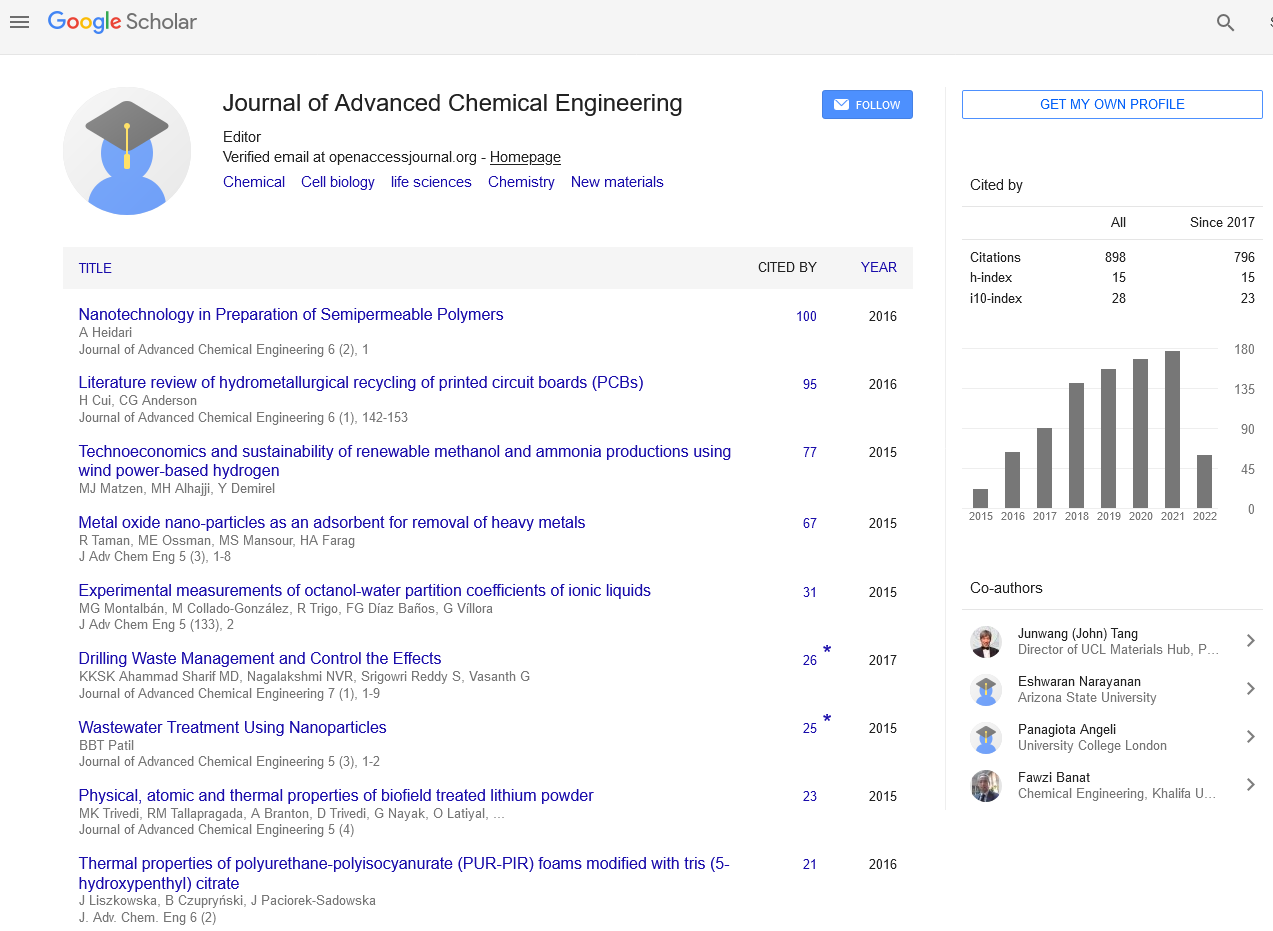Indexed In
- Open J Gate
- Genamics JournalSeek
- Smithers Rapra
- RefSeek
- Directory of Research Journal Indexing (DRJI)
- Hamdard University
- EBSCO A-Z
- OCLC- WorldCat
- Scholarsteer
- Publons
- Geneva Foundation for Medical Education and Research
- Google Scholar
Useful Links
Share This Page
Journal Flyer

Open Access Journals
- Agri and Aquaculture
- Biochemistry
- Bioinformatics & Systems Biology
- Business & Management
- Chemistry
- Clinical Sciences
- Engineering
- Food & Nutrition
- General Science
- Genetics & Molecular Biology
- Immunology & Microbiology
- Medical Sciences
- Neuroscience & Psychology
- Nursing & Health Care
- Pharmaceutical Sciences
Effectiveness of pyrrolidinium ionic liquids as gas hydrate inhibitors
2nd International Conference on Advances in Chemical Engineering and Technology
November 16-17, 2017 | Paris, France
M Fahed Qureshi, Tausif AlTamash, Majeda Khraisheh, Mohammad Ali Saleh and Mert Atilhan
Qatar University, Qatar
Texas A&M University, USA
Posters & Accepted Abstracts: J Adv Chem Eng
Abstract:
Natural gas hydrates are ice-like crystalline compounds that are formed under higher pressure and low temperature conditions within offshore subsea lines. The formation of hydrate clusters is hazardous as they have the tendency to completely block the oil and gas pipelines and cause safety concern to nearby operators. Therefore, industry use thermodynamic hydrate inhibitors (THI) like methanol and mono-ethylene glycol (MEG) to prevent the risk of hydrate formation in offshore subsea lines. However, the major concern with the use of THI is that they are required in bulk quantity (>30 wt%), are highly flammable and cannot be easily dispose of into the environment. Ionic liquids (ILs) are organic salts with low melting point that have a tendency to exist in a liquid state at ambient temperature. They are widely applied in green chemical processes due to their negligible vapor pressure and low viscosity. Recently, ILs has been identified as the dual functional inhibitors as they can act as thermodynamic hydrate inhibitor and kinetic hydrate inhibitor both simultaneously. The thermodynamic inhibition (TI) and kinetic inhibition (KI) effectiveness of the IL varies with the amount used and the length of IL alky chain. In this work, the thermodynamic inhibition (TI) and kinetic inhibition (KI) effectiveness of pyrrolidinium based Ionic liquids (ILs) 1-Methyl-1-Propyl-pyrrolidinium Chloride [PM-Py][Cl] and 1-Methyl-1- Propyl-pyrrolidinium Triflate [PM-Py][Triflate] have been studied using quaternary gas mixture (Methane C1: 85.24 %, Ethane C2: 10.03 %, Carbon dioxide CO2: 2.49%, Nitrogen N2 : 2.22 and n-hexane C6+ : 0.02 %) on the rocking cell assembly (RC-5). The experiments are conducted using different concentrations (1-5 wt %) of ILs and within the pressure range of 40-120 bars. The experimental results, show that the selected ILs act as thermodynamic and kinetic inhibitors both simultaneously. The addition of synergents compounds like Caprolactum (VCAP) and Polyethylene Oxide (PEO) in equal ratio helps to improve their kinetic and thermodynamic inhibition effectiveness of ILs significantly. Acknowledgment: Author M Fahed Qureshi would like to acknowledge GSRA. This work was made possible by GSRA # 2-1-0603-14012 from the Qatar National Research Fund (a member of Qatar Foundation). The statements made herein are solely the responsibility of the authors.
Biography :
M Fahed Qureshi.is currently a PhD fellow at Qatar University conducting research on improving effectiveness of low environmental impact gas hydrate inhibitors. He holds MSc degree in Chemical Process Research & Development from University of Leeds UK and has previously worked with Total E& P Qatar in Acid Stimulation project. He is also an associate member of Royal Society of Chemistry and Institute of Chemical Engineers UK. Currently, he has three publications in the field of gas hydrates and has been awarded Graduate studies research award for his PhD work by Qatar National Research Funds (QNRF). He is strongly interested in industry based research and entrepreneurship work.


